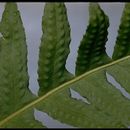Comments
provided by eFloras
R. M. Lloyd and F. A. Lang (1964) recognized two cytotypes within Polypodium californicum . The tetraploid has proved to be an allopolyploid involving P . californicum and P . glycyrrhiza and is treated here as a separate species, P . calirhiza , following S. A. Whitmore and A. R. Smith (1991). Polypodium californicum can be confused with P . calirhiza , but it usually can be distinguished by blade shape, venation, spore size, and geographic distribution. D. S. Barrington et al. (1986) reported that spores of northern populations of P . californicum can be as large as those of P . calirhiza , but the former species has veins forming more areoles per segment than does the latter.
- license
- cc-by-nc-sa-3.0
- copyright
- Missouri Botanical Garden, 4344 Shaw Boulevard, St. Louis, MO, 63110 USA
Description
provided by eFloras
Stems dull or inconspicuously glaucous, moderately stout, to 10 mm diam., acrid or bland-tasting; scales uniformly brown or slightly darker near point of attachment, lanceolate-ovate, symmetric, margins entire to erose. Leaves to 70 cm. Petiole usually slender, to 3 mm diam. Blade deltate to lanceolate-ovate, pinnatifid, usually widest near base, to 20 cm wide, leathery to herbaceous; rachis sparsely scaly to glabrescent abaxially, puberulent adaxially; scales deltate to ovate, usually more than 10 cells wide. Segments linear-lanceolate to oblong, usually less than 15 mm wide; margins serrate; apex widely obtuse to rarely attenuate; midrib puberulent adaxially. Venation weakly to conspicuously anastomosing, most segments containing several areoles, often forming 1 row. Sori midway between margin and midrib or slightly closer to midrib, usually less than 3 mm diam., oval when immature. Sporangiasters absent. Spores less than 58 µm, verrucose, with surface projections to 3 µm. 2 n = 74.
- license
- cc-by-nc-sa-3.0
- copyright
- Missouri Botanical Garden, 4344 Shaw Boulevard, St. Louis, MO, 63110 USA
Habitat & Distribution
provided by eFloras
Sporulating early winter--spring. Cliffs and soil on rocky slopes; on a variety of substrates but usually igneous; 0--1500 m.; Calif.; Mexico in Baja California.
- license
- cc-by-nc-sa-3.0
- copyright
- Missouri Botanical Garden, 4344 Shaw Boulevard, St. Louis, MO, 63110 USA
Synonym
provided by eFloras
Polypodium californicum var. kaulfussii D. C. Eaton; P. vulgare Linnaeus subsp. californicum (Kaulfuss) Hultén; P. vulgare var. kaulfussii (D. C. Eaton) Fernald
- license
- cc-by-nc-sa-3.0
- copyright
- Missouri Botanical Garden, 4344 Shaw Boulevard, St. Louis, MO, 63110 USA

